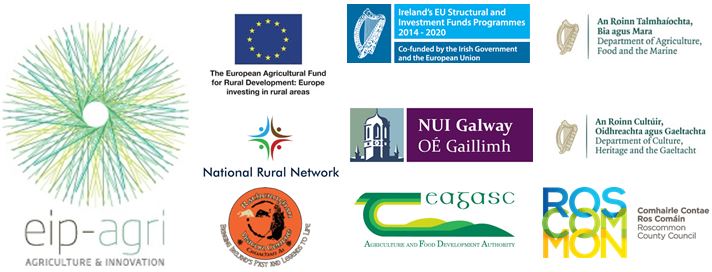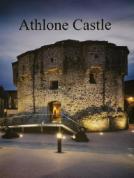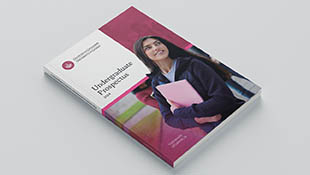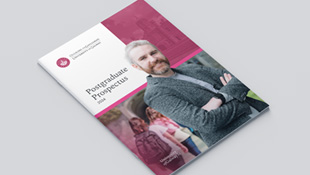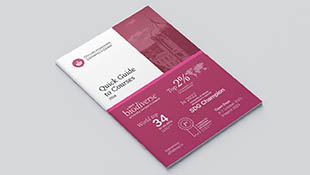-
Courses

Courses
Choosing a course is one of the most important decisions you'll ever make! View our courses and see what our students and lecturers have to say about the courses you are interested in at the links below.
-
University Life

University Life
Each year more than 4,000 choose University of Galway as their University of choice. Find out what life at University of Galway is all about here.
-
About University of Galway

About University of Galway
Since 1845, University of Galway has been sharing the highest quality teaching and research with Ireland and the world. Find out what makes our University so special – from our distinguished history to the latest news and campus developments.
-
Colleges & Schools

Colleges & Schools
University of Galway has earned international recognition as a research-led university with a commitment to top quality teaching across a range of key areas of expertise.
-
Research & Innovation

Research & Innovation
University of Galway’s vibrant research community take on some of the most pressing challenges of our times.
-
Business & Industry

Guiding Breakthrough Research at University of Galway
We explore and facilitate commercial opportunities for the research community at University of Galway, as well as facilitating industry partnership.
-
Alumni & Friends

Alumni & Friends
There are 128,000 University of Galway alumni worldwide. Stay connected to your alumni community! Join our social networks and update your details online.
-
Community Engagement

Community Engagement
At University of Galway, we believe that the best learning takes place when you apply what you learn in a real world context. That's why many of our courses include work placements or community projects.
Community Outreach: Sharing Research with Connacht Communities
Investing in community
It is apparent that communities throughout Ireland have become increasingly interested in understanding the history and archaeology of their local areas and parishes. At least some of this interest seems to be a reaction to the hubris, short-termism and greed of the Celtic Tiger years and is linked to a realisation in many of these communities that sustainable streams of income need to be put in place at a local level in order to halt rural and urban decline. In many places, cultural tourism has been identified by these communities as having the potential to help economic growth. This is partly based on the fact that international research has demonstrated that cultural tourists spend substantially more than ordinary tourists. In this respect, many community leaders and activists now realise that archaeological and historical sites, places of cultural interest, have an economic value because they attract visitors, who generate much-needed income and employment. Furthermore, although harder to quantify, this growing interest in heritage is also linked to a genuine curiosity about and respect for the past. The resurgence of these traditional values in the last number of years has to be welcomed. The acknowledgement of a shared past within a community builds bonds across social and economic divides and provides a sense of collective purpose and belonging. Such engagement also builds a sense of pride of place and encourages innovation and enterprise towards the collective stewardship and promotion of local heritage, and most particularly its archaeological monuments and their related historical and literary legacy.
The existence of Heritage Officers in virtually all county councils (an initiative of the Heritage Council) has meant that communities now have professional help to assist them in the task of unlocking the related economic, social and educational potential of their local heritage, in all its aspects. Furthermore, Heritage Officers often act as a conduit between local communities and academics, helping the former access the knowledge and research available in universities and institutes of technology that is of direct relevance to their areas and parishes.
The participants in The Connacht Project, realising all this, endeavour to share their research with local communities throughout the province (and further afield, if need be) for the mutual benefit of all. In particular, a very fruitful collaboration has grown up between Roscommon’s Heritage Officer, Nollaig Feeney, and the Manager of the Rathcroghan Visitor Centre, Dr Daniel Curley and The Connacht Project over the years.
Farming Rathcroghan
The endeavours of the Rathcroghan Resource Community (RRC) provides a particularly good example of just such an imaginative collaborative initiative. It was successful in its bid in 2018, under the European Innovation Partnership (EIP-Agri) scheme, through the Department of Agriculture, Food and the Marine, for its project entitled ‘Farming Rathcroghan: Sustainable Farming in the Rathcroghan Archaeological Landscape’ and was awarded a grant of €0.98m to implement this project over the course of the next five years (see: https://www.nationalruralnetwork.ie/innovation).
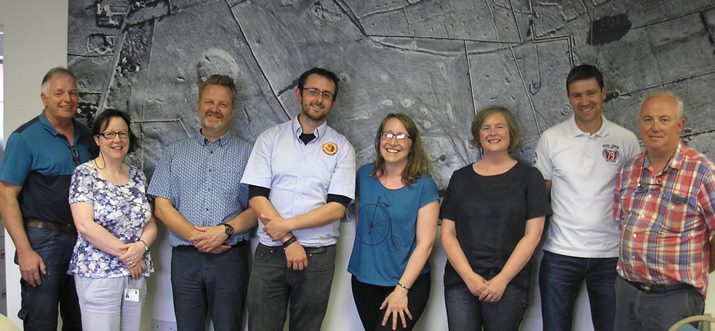 |
| Photograph Caption: At a meeting of the Rathcroghan Resource Community in the Rathcroghan Visitor Centre on 11 July 2018; (left to right) Mr Gabriel O’Grady, Rathcroghan Farmer; Ms Nollaig Feeney, Heritage Officer, Roscommon County Council; Mr Joe Fenwick, Archaeology, School of Geography and Archaeology, NUI Galway; Mr Daniel Curley, Project Coordinator/Manager, Rathcroghan Visitor Centre; Dr Caitriona Maher, Project Plan Consultant/Author; Ms Helena Fitzgerald, Project Plan Consultant/Author, Mr Gerard Healy, Rathcroghan Farmer; Mr Michael Scott, Rathcroghan Farmer. |
The Farming Rathcroghan Project was developed using a locally led partnership approach. Its operational group, the Rathcroghan Resource Community, consists of a Lead Partner, Farming Rathcroghan CLG (comprising directors from Rathcroghan Farmers, Tulsk Action Group and Rathcroghan Visitor Centre) and various Operational Advisory Group Members comprising of: Archaeology, School of Geography, Archaeology & Irish Studies, University of Galway; Roscommon County Council; Teagasc, Agriculture and Food Development Authority; National Monuments Service, Department of Culture, Heritage and the Gaeltacht).
Rathcroghan is a particularly well-preserved and internationally significant archaeological landscape, one of a small group of Late Prehistoric ‘royal’ sites throughout Ireland that have been included under the Department of Tourism, Culture, Arts, Gaeltacht, Sports and Media’s tentative list for UNESCO World Heritage Status (under the ‘Royal Sites of Ireland’). The Farming Rathcroghan Project’s objectives are to manage, care for and conserve this important cultural landscape through the implementation of a programme of economically sustainable and ecologically sound farming practices. It also aims to promote its rich archaeological and historical heritage and facilitate visitor access to the area. The project has formulated, tested and developed a suite of innovative management solutions designed to sustain a viable and vibrant rural farming community in the context of a culturally and ecologically sensitive landscape. The project has also raised awareness among the general public of the significance of Rathcroghan as a farmed archaeological landscape and has promoted the proactive role of farmers and farming in the care and maintenance of the living landscape in harmony with its remarkable cultural heritage and ecological assets.
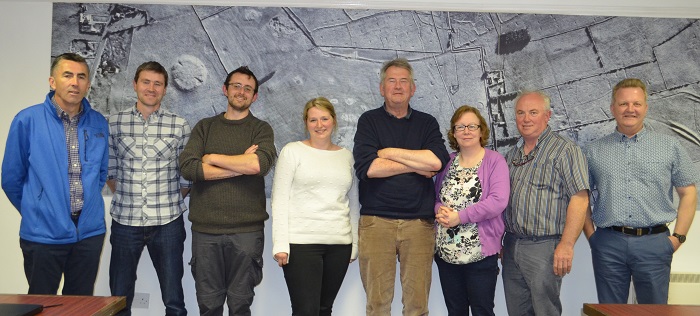 |
| Photograph caption: At a meeting of the Farming Rathcroghan Project in the Rathcroghan Visitor Centre on 23 May 2019; (left to right) Mr Kieran Kenny, Teagasc; Mr Gerard Healy, Rathcroghan Farmer; Mr Daniel Curley, Project Coordinator/Manager, Rathcroghan Visitor Centre; Ms Petra Kock-Applegren, Manager, Farming Rathcroghan Project; Dr Kieran O'Conor, Archaeology, School of Geography, Archaeology and Irish Studies; Ms Nollaig Feeney, Heritage Officer, Roscommon County Council; Mr Michael Scott, Rathcroghan Farmer; Mr Joe Fenwick, Archaeology, School of Geography and Archaeology, NUI Galway. |
As part of this programme it has implement a range of best farming and archaeological practice to actively monitor, manage and maintain this ancient cultural landscape in an environmentally and ecologically-friendly way. Through engagement with key stakeholders and the National Monuments Service, archaeological expertise has also been made available through the Farming Rathcroghan Project to facilitate the protection and conservation of the archaeological earthworks and the built heritage of the Rathcroghan area. This aspect of the project has proven to be remarkably effective. These and the other innovations have enormous potential in other culturally sensitive farming landscapes throughout Ireland and the European Union and so has become the flagship project for others to follow in the years to come.
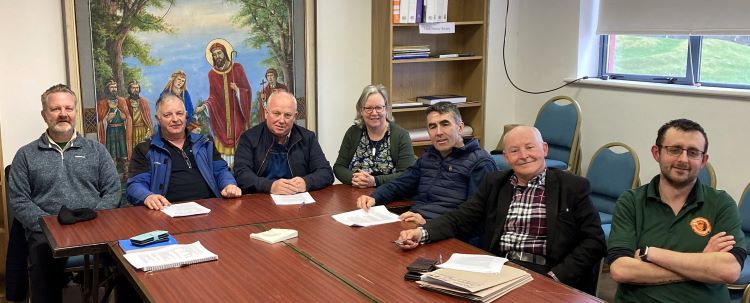 |
|---|
|
Photograph caption: At a meeting of the Farming Rathcroghan Project in the Rathcroghan Visitor Centre on Friday, 1 September 2023; (left to right) Mr Joe Fenwick, Archaeology, University of Galway; Mr Gabriel O’Grady, Rathcroghan farmer; Mr Michael Scott, Rathcroghan Farmer; Ms Nollaig Feeney, Heritage Officer, Roscommon County Council; Mr Kieran Kenny, Teagasc; Mr Richie Farrell, Manager, Farming Rathcroghan (2023-24); Mr Daniel Curley, Manager, Rathcroghan Visitor Centre. |
The Farming Rathcroghan Project has been enormously successful over the course of its five-year programme (see: https://www.nationalruralnetwork.ie/innovation). It will draw to a conclusion in April of 2024, but on the foundations of its success, plans for new more ambitious project, Rathcroghan Heritage Farming, is currently well advanced.
(Indirectly related to the Farming Rathcroghan Project is a recent submission to the Department of Arts, Heritage and the Gaeltacht in relation to Heritage Ireland 2030. See: Heritage Ireland 2030 submission to DoAH&G by Joe Fenwick 2019)
Publications linked to Community Outreach: Sharing Research with Connacht Communities.
Guidebooks
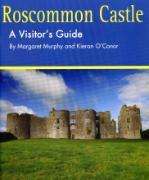 |
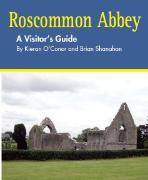 |
|
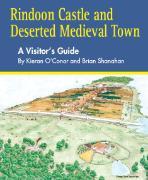 |
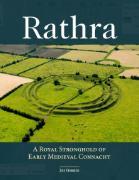 |
Margaret Murphy and Kieran O'Conor. 2008, Roscommon Castle - A Visitor's Guide. Roscommon County Council: Roscommon.
Kieran O'Conor and Brian Shanahan. 2013, Roscommon Abbey - A Visitor's Guide. Roscommon County Council: Roscommon.
Rory Sherlock. 2016, Athlone Castle: An introduction to the history and architecture of Athlone Castle, Westmeath County Council.
Kieran O’Conor and Brian Shanahan. 2018, Rindoon Castle and Deserted Medieval Town - A Visitor's Guide. Roscommon County Council: Roscommon.
Fenwick, J. 2021 Rathra: a royal stronghold of early medieval Connacht. Roscommon County Council: Roscommon.
Heritage Guides
John Waddell. 2009, Rathcroghan, Co. Roscommon - where the Táin Bó Cúailnge began, Archaeology Ireland Heritage Guide No. 44, Wordwell, Dublin.
(Guidebooks & Heritage Guides are available for purchase at the Rathcroghan Visitor Centre or through its ONLINE SHOP)
Information Boards
Kieran O’Conor wrote the text for the seven information boards located in different parts of the deserted medieval town and castle at Rindoon, Co. Roscommon.
Joe Fenwick and John Waddell provided the information and many of the images for the display at Rathcroghan Visitor Centre, Tulsk, Co. Roscommon.
Margaret Murphy and Kieran O’Conor wrote the text for the information board at Roscommon Castle.








